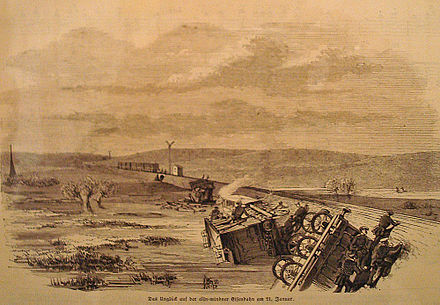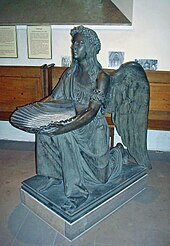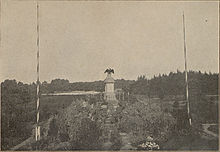Avenwedde railway accident

The railway accident at Avenwedde near Gütersloh on January 21, 1851, with three fatalities, was the worst railway accident in Germany to date and also the first accident involving a passenger train in Germany with several deaths. In the incident, the accompanying Prince Friedrich Wilhelm of Prussia , who later became Emperor Friedrich III, was slightly injured.
Starting position
The express train was pulled by a steam locomotive with the wheel arrangement 1A1 with an extended boiler and the name Gütersloh . It was very long that day. The exact number of cars is not explicitly found in any source, but there were probably ten, one baggage car and nine passenger cars . The train was well manned as a large horse auction had taken place in Bielefeld . The train was supposed to leave here at 1:36 p.m. and arrive at the next station, Gütersloh, at 2:05 p.m. He drove over the main line of the Cologne-Mindener Eisenbahn-Gesellschaft, which had been opened four years earlier .
Prince Friedrich Wilhelm studied from 1849 to 1852 at the Rheinische Friedrich-Wilhelms-Universität Bonn . He had traveled to Berlin for a few days on the occasion of the 150th anniversary of Prussia's acquisition of the royal dignity on January 18, 1851 , and was accompanied by Premier Lieutenant von Heiz († 1867), who later became the Prince's court marshal , and Colonel Friedrich Leopold Fischer (1798–1857), later major general , on the return trip to Bonn . At this point in time he was second to the Prussian line of succession after his father , i.e. not yet crown prince . The prince had left the Anhalter Bahnhof in Berlin on the evening of January 20, 1851 . In Minden, the prince and his companions boarded a train belonging to the Cologne-Mindener Eisenbahn-Gesellschaft and drove with it towards Cologne-Deutz . The prince traveled on this train in the last compartment reserved for him and his companion , one of the first carriage class , in the fourth carriage of the train.
the accident
The accident occurred at 13:44 in the area of today's station Isselhorst - Avenwedde , which was set up but not until 1891, immediately west of the point where the current county road 35, the railway crossing. On the rail side, it is now 121.9 km of the Hamm – Minden railway line . The steam locomotive skidded at around 60–80 km / h, derailed and fell down the approximately 5 meter high embankment . Your Tender rushed to the locomotive , the train driver was crushed and died instantly. The stoker died of the burns he had suffered at the scene of the accident. The derailing locomotive pulled the following four cars with it, which also derailed, tearing their couplings and those to the rest of the train. The three cars following the locomotive also fell down the embankment. The first car following the locomotive and tender, the baggage car, was completely smashed. In the third car, the US Secretary of the Mission , John B. Andre, traveled from New York , who tried to save himself by jumping off, but was killed by the overturning vehicle . He was on his way to his wedding in New York. According to another source, it is said to have been the attaché of the US legation, Mr. Ward.
The fourth car - in which the prince was traveling - derailed and overturned, but came to a stop on the embankment, on the track in the opposite direction. In this respect, the illustration from the Illustrirten Zeitung gives an incorrect representation. Prince Friedrich Wilhelm suffered a heavily bleeding injury to the back of the head - depending on the source, there is talk of abrasions , a splinter injury or a bruise . He and his companions could climb outside through a window. There was also the report that the prince had "arrived safely back in Berlin at 4 am on January 22nd, and only has a cold, which he had already taken from Berlin".
In addition, four railway workers and three travelers were injured. Numerous horses also died or were injured.
The brakeman , who was riding on the fifth car, applied the brakes so quickly and sharply that the coupling to the derailing car in front of him tore, preventing the derailing of the following cars, which could be brought to a stop after a few hundred meters.
consequences
Immediate consequences
A relief train was dispatched from Gütersloh train station , which also took the travelers there. There they had to wait for a replacement train from Hamm when it was very cold , which would enable them to continue their journey. The prince and his companion were accommodated in the completely overcrowded train station in the station office.
By order of the Prussian King Friedrich Wilhelm IV. , On the following Sunday, January 26th, in the churches of Berlin and the following Sunday in the churches of the whole kingdom, thanks were given for the rescue of the prince as part of the intercessory prayer for the royal family .
The Cologne-Mindener Eisenbahn-Gesellschaft tried to downplay the accident. In its official announcement it was claimed that the cause of the accident could not be determined. The prince as an injured traveler was not mentioned at all - but in the press.
Determination of the cause of the accident
For an accident in which the “highest gentlemen” suffered damage, the subsequent accident investigation was, from today's perspective, quite superficial and amateurish. Apparently only the railway company itself investigated and came - officially - to the result that the cause of the accident could not be determined - according to its official statement in the Kölnische Zeitung of January 23, 1851 (No. 20). Two causes of the accident are discussed: an insufficiently paved track - track construction work is said to have taken place at the accident site - and a faulty locomotive construction. The former can be ruled out: the cars that were not derailed passed the scene of the accident braking before they came to a stop after a few hundred meters. It is impossible that six passenger cars have driven over a fault in the track without derailing. It is far more likely that a design error made the locomotive from Robert Stephenson's workshop unable to drive at higher speeds. Without changing the axial distances, he locomotives with a longer boiler, a so-called Long boiler built. The boiler, which now protrudes far beyond the outer axles, could cause the locomotive to vibrate, which in extreme cases threw it off the tracks. Several such accidents are known.
The maximum speed allowed for this type of locomotive was immediately limited and they were withdrawn from express train service . The locomotives were rebuilt in the following period by moving the rear axle further back in order to achieve the required smoothness, which was also successful.
Commemoration
To the Martin Luther Church (before 1911: New Church or New Evangelical Church , between 1911 and 1933: Resurrection Church ) in Gütersloh, Prince Friedrich donated the sculpture of a baptismal angel by Bertel Thorvaldsen for his rescue in the railway accident . It is a zinc die-cast from the Moritz Geiß workshop , Berlin. The baptismal angel was made from marble based on a model that is in the Frauenkirche in Copenhagen . The Gütersloh angel bears the dedication on the fold of the robe resting on the base: Gütersloh, January 21, 1851 .
As a further reminder of the accident, a memorial was created directly at the accident site in 1866: a soaring eagle standing on a pedestal, initially made of sandstone . During the renovation of the monument in 1888, a bronze eagle based on a model by Christian Daniel Rauch was attached. After the construction of the Isselhorst-Avenwedde station in 1891 and the extension of the railway line to four tracks, the memorial had to be moved 200 meters to the east and south of the tracks. The bronze eagle was melted down during the First World War as a " metal donation from the German people " and replaced by one made of sandstone. In 1969 or 1970 the memorial was torn down - by whom it remains unclear, no one wanted to take responsibility for it in retrospect.
Worth knowing
In the literature, the accident is also referred to as the railway accident near Gütersloh , the railway accident in Isselhorst and the railway accident in Gütersloh-Isselhorst . The railway line runs in the area in which the accident happened, but in the district of Avenwedde . The district of Isselhorst is only neighboring.
literature
- Ulrich Felchner: The “Gütersloh Baptism Angel” in a new light . In: Gütersloher Contributions to Heimat- und Landeskunde 56/57 (1997), pp. 1263–1284.
- Friedrich Fischer: Crown Prince injured, engine driver Klein was immediately dead . In: Heimat-Jahrbuch Kreis Gütersloh 1992, pp. 59–63.
- Franz Flaskamp: The Kronprinz-Friedrich-Wilhelm-Stiftungen in the district of Wiedenbrück (= sources and research on the nature and history of the district of Wiedenbrück 1). Hildesheim 1929.
- NN: The railway accident at Isselhorst in 1851 . In: Brackweder Heimatblätter, year 1967, pp. 26–28.
- Ernst Osterrath : The Crown Prince monument of the Wiedenbrück district in the Avenwedde community near Isselhorst train station in Westphalia . Ed .: District Committee of the Wiedenbrück District. Wiedenbrück 1898, urn : nbn: de: hbz: 6: 1-72876 .
- Hans Joachim Ritzau: Shadow of the railway history . Pürgen 1987.
- Andreas Sassen: The Crown Prince Monument at the Isselhorst-Avenwedde train station = contributions to the history of the Isselhorst parish. Gutersloh.
Individual evidence
- ↑ Sassen, p. 8.
- ↑ Osterrath, p. 4 .
- ↑ Sassen, p. 3f, secondarily cites the anonymous report of "a railway specialist" from the Neue Westfälische of January 21, 1976, which reports of four derailed and six remaining on the track; The same is evident from the wood engraving that appeared in the Leipziger Illustrierte Zeitung about the accident .
- ↑ Sassen, p. 3, notes 1 and 2.
- ↑ Sassen, p. 3, and NN: Das Eisenbahnunlück , p. 26, assume that it was a continuous train from Berlin. However, the prince reports in a letter (Sassen, p. 5) that he got into the car in Minden in which he had an accident and Fischer, p. 63, gives an extract from the timetable from 1851, which also shows that travelers between Berlin and the Cologne-Minden Railway had to change trains in Minden.
- ↑ Osterrath, p. 6 ; see: Letter from Prince Friedrich Wilhelm to Zastrow of January 29, 1851, quoted in Sassen, p. 5.
- ^ NN: The railway accident , p. 26.
- ↑ Sassen, p. 3.
- ↑ Sassen, p. 3.
- ↑ Osterrath, p. 5 .
- ↑ Flaskamp, p. 11.
- ↑ Sassen, p. 5.
- ↑ Daily news. In: foreigners sheet of the imperial and royal capital Vienna / foreigner sheet and tag news of the imperial and royal capital Vienna / foreigner sheet / foreigner sheet with Vedette / foreigner sheet with military supplement Die Vedette , January 26th 1851, p. 2 (online at ANNO ).
- ^ Letter from Prince Friedrich Wilhelm to Zastrow of January 29, 1851, quoted in Sassen, p. 5.
- ↑ Flaskamp, p. 11.
- ^ Sassen, p. 5; Osterrath, p. 7 incorrectly assumes an injury to the forehead.
- ↑ Fischer, p. 59.
- ↑ Berlin, January 23. In: Grätzer Zeitung. The attentive one. Steyermärkische intelligence papers. Steyermärkisches intelligence sheet. Steyermärkisches Official Journal / Stiria, a sheet of the useful and the beautiful / Gratzer Zeitung. Styrian Official Gazette , January 27, 1851, p. 3 (online at ANNO ).
- ↑ Osterrath, p. 5 .
- ^ Sassen, p. 5; Osterrath, p. 10 .
- ↑ The corresponding decree of the Royal Consistory is printed in: Osterrath, p. 13ff .
- ↑ Sassen, p. 6f.
- ↑ Felchner, pp. 1269f; Sassen, p. 7.
- ↑ Osterrath, p. 11 .
- ↑ Sassen, p. 7.
- ↑ Ritzau, Schatten, Vol. 4.
- ↑ Sassen, p. 7f.
- ↑ See in particular: Felchner.
- ↑ Sassen, p. 11.
- ^ Sassen, p. 16 (plan); NN: The railway accident , p. 28.
- ↑ Flaskamp, p. 15ff.
- ↑ Sassen, p. 19ff.
- ↑ Osterrath, p. 3 .
- ↑ Flaskamp, plan as an attachment.
Coordinates: 51 ° 56 ′ 18.8 " N , 8 ° 26 ′ 10.4" E


